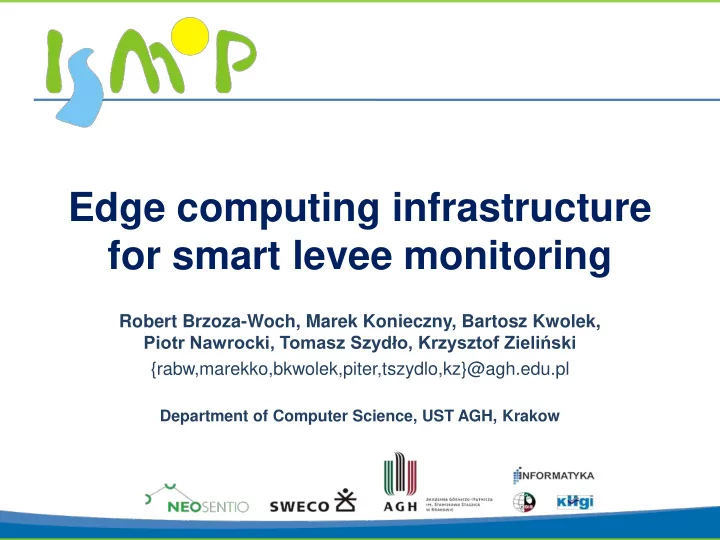

Edge computing infrastructure for smart levee monitoring Robert Brzoza-Woch, Marek Konieczny, Bartosz Kwolek, Piotr Nawrocki, Tomasz Szydło, Krzysztof Zieliński {rabw,marekko,bkwolek,piter,tszydlo,kz}@agh.edu.pl Department of Computer Science, UST AGH, Krakow
Motivation • Flood warning systems utilize sensors to acquire data from monitored infrastructure • Recent development in Internet of Things environments gives us the new perspective on the design of monitoring systems • The systems often have hierarchical architecture - sensors gather data and later transmit them to a central part where further processing take place • One of the ideas we decide to use is edge computing 2
Edge Computing Concept • In the Edge Computing • In a classical approach to concept the data gathered by WSN, the data gathered by sensors can be processed sensors are transmitted close to the sensors and only usually through the mesh or selected preprocessed tree topology to a central results can be transmitted to system for processing the central system 3
System Layers • The computerized monitoring and decision support system has a layered architecture that consists of the following layers: – Measuring layer - composed of the sensors or sensor networks deployed in the levee. – Edge computing layer - composed of the many distributed telemetry stations which collects data from the measuring layer, process it and transmits to the central part of the system for further processing. – Communication layer - provides bidirectional communication between Edge Computing layer and the central part of the system. 4
Edge Computing Layer • The edge computing paradigm provides to the system following properties: – local data processing introduced in the edge computing layer gives the possibility to process data in place and transmitting only the computation results – intelligent communication allows smart rerouting of measuring data among other telemetry stations to the central part of the ISMOP IT system, in a case of problems with direct connection – self-organization capabilities of the edge computing system reorganize internal processing architecture to encompass the ever-changing runtime conditions 5
Local Data Processing • The local threat level assessment may be performed in case the communication with Internet is lost • The gathered data can be processed in-place and only results can then be transmitted to either reduce required bandwidth or to minimize the amount of redundant information submitted to a central data base • Each station should be able to acquire data from more than a thousand of sensors, hence the information preprocessing, such as compression and encryption may be necessary 6
Communication Mechanisms • Vertical Communication provides the communication path between a station and a central system (or the Internet) • Horizontal Communication shall be utilized to: – locally distribute measurements, computing tasks and results between the stations; – provide a local low-latency communication path in case of an emergency situation – then a rescue team can connect directly to the local fog network and obtain the environmental condition information; – provide an alternate communication path during normal or emergency situation every time the VC channel is unavailable. 7
System Design Telemetry Station Telemetry Station • Autonomous Power Supply and Energy AUTONOMOUS POWER SUPPLY Storage delivers the energy needed by AND ENERGY STORAGE the device from renewable sources ADC local sensors • ESS with VC and HC AMBC Based on the complexity of computation DIO the Embedded Supervising System (ESS) local bus USI can schedule the task execution sensor module sensor module – The tasks can be executed directly on ESS or Application Microprocessor-based Computer (AMBC) – As the result of this approach less demanding tasks can be run without powering up main AMBC unit • Various types of communication – Horizontal Communication (HC) for communication between telemetry nodes – Vertical Communication (VC) for sending information to the Central Subsystem – The interaction between the telemetry station and sensors is done via the Unified Serial Interface (USI) 8
Telemetry Station Prototype 9
Summary • The ISMOP project positively verified the proposed concept of edge computing infrastructure for Smart Levee Monitoring – Essential part of this infrastructure consists of the telemetry stations designed following edge computing concept • Future work involves further research and development of their internal hardware and software 10
Bibliography • B. Balis, R. Brzoza-Woch, M. Bubak, M. Kasztelnik, B. Kwolek, P. Nawrocki, P. Nowakowski, T. Szydlo, and K. Zielinski. Holistic approach to management of IT infrastructure for environmental monitoring and decision support systems with urgent computing capabilities. Future Generation Computer Systems. 2016. In Press. • R. Brzoza- Woch, M. Konieczny, B. Kwolek, P. Nawrocki, T. Szydło, and K. Zieliński. Holistic approach to urgent computing for flood decision support. Procedia Computer Science, 51, pp.2387-2396. 2015. • Brzoza-Woch, R., Konieczny, M., Nawrocki, P., Szydlo, T., & Zielinski, K. (2016, May). Embedded systems in the application of fog computing — Levee monitoring use case. In Industrial Embedded Systems (SIES), 2016 11th IEEE Symposium on (pp. 1-6). IEEE. 11
Thank you Acknowledgments This work was partially supported by the National Centre for Research and Development (NCBiR) under Grant No. PBS1/B9/18/2013 and by the Polish Ministry of Science and Higher Education under AGH – University of Science and Technology Grant 11.11.230.124 (statutory project).
Recommend
More recommend